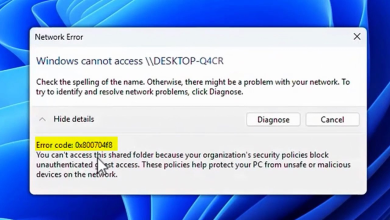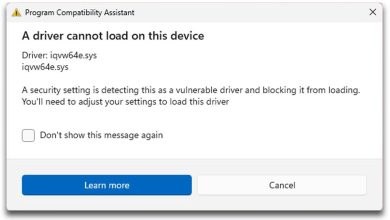How to Find and Fix Packet Loss on Windows 10/11
In simple terms, packet loss means that one or more data packets have failed to reach their destination while traveling across a network. Packet loss is the reason why you suffer lag in games, distortion in calls, and low quality in videos.

Constant packet losses hinder your internet experience, and you’ll keep facing lags and disturbances here and there. You can’t play online games or attend audio or video calls properly.
Even if you do, you will face low-quality (almost robotic) voices during calls. Having said that, packet losses are not something to be ignored.
What Causes Packet Loss on a PC?
The main reasons why packet loss occurs are due to data transmission errors, damaged cables, and weak WiFi signals. However, there are multiple other reasons as well.
- Data Transmission Errors: When a data packet gets lost or an incorrect one is received, you’ll experience packet loss on your system.
- Damaged Internet Cable: A damaged internet cable means that your router’s connection to the switchboard is not 100% stable, and hence data packets are being lost.
- Weak Wi-Fi Signals: If your router is too far away from your PC, you’ll get lower signal strength, which directly contributes to packet loss.
- Signal Interfering Devices: Devices like baby monitors, walkie-talkies, and microwaves should be kept away from your Wi-Fi router; otherwise, they can weaken the signals.
- Extra Load on the Network: It doesn’t matter how good your internet speed and signals are; if you connect dozens of devices to your network, it will surely have some negative effects on the signals’ strength. This usually occurs while using public Wi-Fi networks.
- Virus in the System: This issue is related to your computer. Make sure the system is free from malware and viruses, as they are the reason behind many issues.
How to Check Packet Loss?
- Click on Start.
- Type cmd.
- Right-click on Command Prompt.
- Select Run as Administrator.
- Enter the following command:
ipconfig
- Note the Default Gateway address.
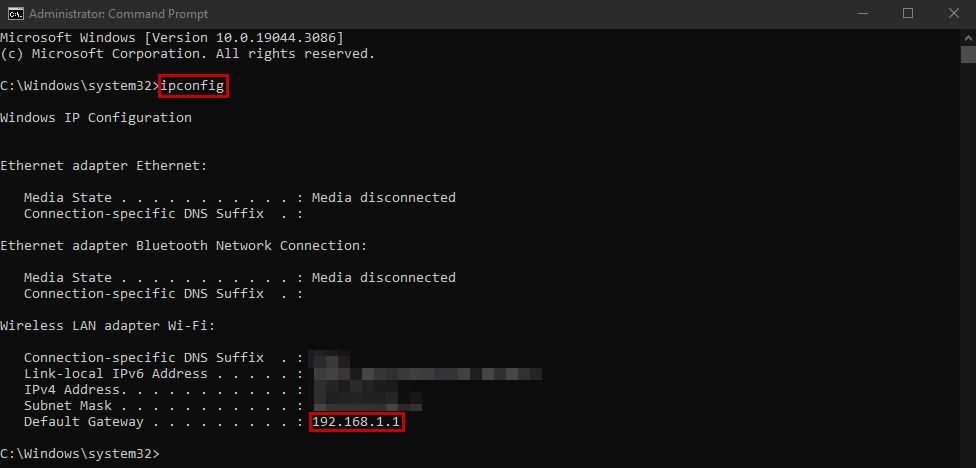
Now run the packet loss test on the command prompt with the following command:
ping (your gateway IP) -n 25

Note: Replace (your gateway IP) with the IP address you noted. Secondly, the number after -n determines how many times the test will run. You can run it more times (75, 100, etc.) for a better result.
Now check the % of packet loss. If it is high, move to the fixes section.
And for instance, if you want to check whether packet loss occurs while accessing some websites, then you can do that as well. Same goes for games, if you are facing packet loss in Games. Go to Google and search for their Server’s IP address and then simply replace the IP address with the games
Let’s say we want to check it for Google.com. The default gateway for Google is 8.8.8.8. Here’s the command we need to enter now:
ping 8.8.8.8 -n 25
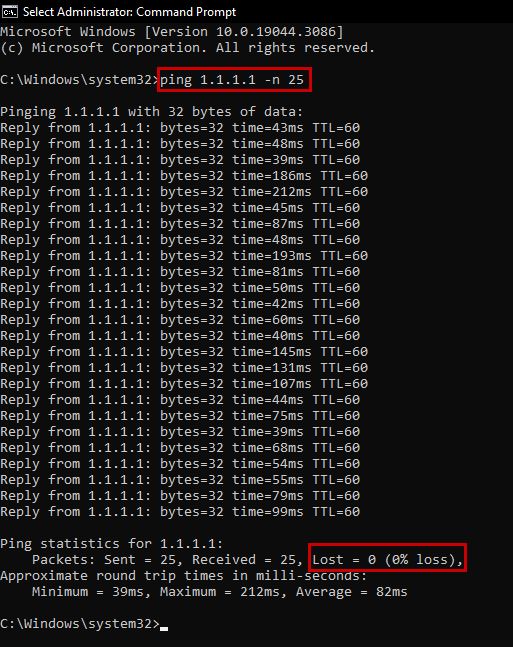
Or you can even write google.com itself, like:
ping google.com -n 25
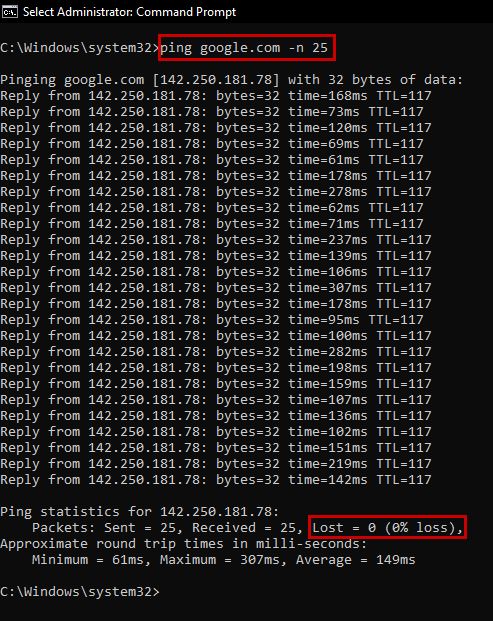
How Do I Fix Windows Packet Loss?
More often than not, moving your router closer, running antivirus, rebooting the router, and connecting via an Ethernet cable will fix the issue. Apart from these solutions, there are some more as well.
1. Replace the Damaged Router Cable
If your router’s power cable has been damaged, then it’s time to replace it. Similarly, if you use ethernet and its cable breaks, then replace it as well.
2. Run the Network Troubleshooter
The Windows network troubleshooter detects if there are problems in your network. Afterward, you can follow its instructions to fix the issue.
Here’s how to run it:
- Click on Start.
- Type Troubleshoot Settings.

- Click on it to open the menu.
- Select Additional troubleshooters.
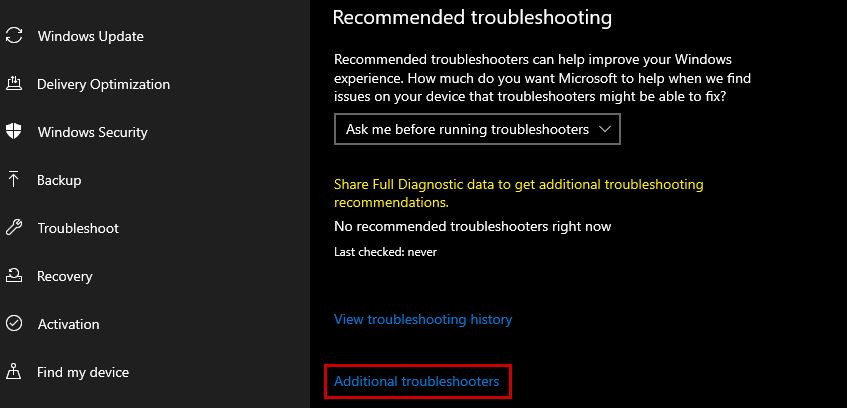
- Click on Network Adapter.
- Select Run this troubleshooter.
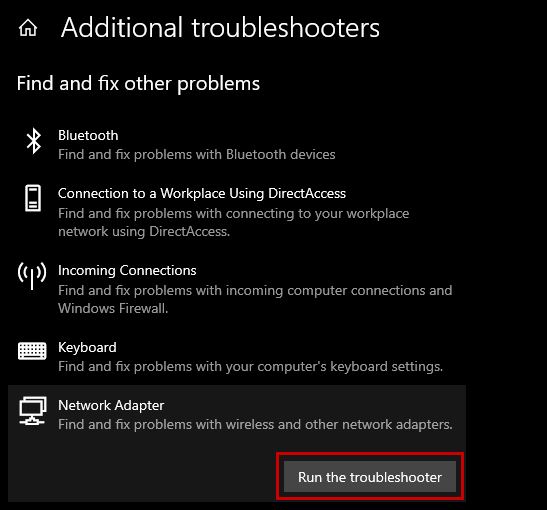
- Now wait for the scan to complete.
3. Reboot your Router
Rebooting your router will give it a fresh start and this often fixes the problems with packet loss since the signals get stable afterward.
- Unplug your router.
- Unplug your modem if you’re using it.
- Wait for at least 30 seconds.
- Plug in the modem.
- Plug in the router.
- Wait for the internet lights to show up.
- Connect to the network.
- Run the packet loss test again.
4. Move Your Router Closer and Away from Interfering Devices
If your PC is too far from your router, then Wi-Fi signals will get weak during their travel, and Windows will face packet loss. In such cases, either move your router closer to the PC or your PC closer to the router.
Secondly, make sure there are no or minimal interfering devices between your router and computer. These devices hinder the Wi-Fi signals, and the connection to your PC gets weak.
5. Remove Network Congestion
Too many connections on one Wi-Fi network is another reason for packet loss and network lag. To identify if this is the problem or not, turn off the Wi-Fi on other devices and check packet loss on your PC now.
6. Run Your Antivirus
You should scan your computer to see whether any viruses are the reason behind the packet loss. Windows built-in security system does the job pretty well, but if you use a third-party antivirus, then you can use it as well.
7. Use an Ethernet Cable
Ethernet cable strengthens the connection by directly connecting the router to your PC or laptop and gets rid of packet loss on Windows. This takes the Wi-Fi signals out of the equation, and you always get a stable connection.
So, simply connect one end of the Ethernet cable behind your router and the other behind your PC. Now run the packet loss test, and there will be improvements.
8. Update Router’s Software
Many routers receive an update that improves their stability, performance, network coverage, and overall performance. In order to update your router, head over to the manufacturer’s website and install the latest version.
If packet loss still occurs on your end, contact your internet service provider (ISP) and let them know of this issue.
 Reviewed by
Reviewed by 
